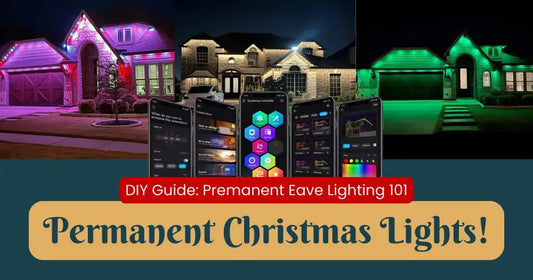Keep Your Holiday Lights On In Wet Weather: A No‑Drama Guide to Waterproof Outdoor Connections
If every drizzle knocks out your display, you don’t have a bad breaker—you have wet connections. This guide shows you how to waterproof outdoor Christmas light connections, stop nuisance GFCI trips, and keep the show glowing through rain, sleet, and snow without sketchy hacks or ugly cord blobs.
Why GFCIs trip when it rains (in plain English)
Ground‑fault circuit interrupters (GFCIs) cut power the instant they sense current leaking to ground—exactly what moisture can cause in plugs, splitters, and sockets. For outdoor décor, using GFCI‑protected receptacles isn’t optional; it’s recommended by consumer safety authorities because it reduces shock risk around wet surfaces. In short: moisture sneaks in, current leaks, GFCI trips, lights go dark. Your job is to keep water out and gravity working for you.


The waterproofing mindset: keep water off the path, out of the plug, and moving down
“Waterproof” isn’t just a product claim—it’s a system. Dry, reliable displays follow three rules:

- Keep connections off the ground and under cover where possible.
- Block direct water paths into plugs and open ends.
- Give water a downhill escape route (drip loops) so it doesn’t wick toward power.
Your rain‑proof toolkit (the essentials we actually use)
- In‑use (bubble) covers at receptacles and a timer or photocell so you’re not opening boxes in bad weather. See our Christmas Light Timers for dusk‑to‑dawn and programmable options, and pair with your outdoor GFCI outlet.
- Moisture shields for mid‑run connections. Our Weatherproof Plug Gaskets & Clear Covers slip between male/female plugs to block water ingress and cap exposed ends when something isn’t plugged in.
- Custom‑length jumpers so connections land where they’ll stay dry. Make clean, exact‑fit leads with SPT1/SPT2 Wire and Slide‑On Vampire Plugs instead of daisy‑chaining bulky cords.
- Proper strain relief to keep plugs aligned and elevated. Match surfaces with Christmas Light Clips for rooflines, gutters, and wireframes.
Step‑by‑step: build weatherproof connections that stay on
-
Start dry and high
- Place your primary timer/photocell inside an in‑use cover at a GFCI‑protected receptacle. That keeps frequent on/off cycles out of the weather and away from puddles. A cover also prevents wind‑driven rain from reaching the plug face.
-
Route power to protected zones
- Before you run a single string, decide where each connection will live. Aim to terminate runs under soffits, on porch ceilings, or beneath window ledges rather than in open splash zones.
-
Use custom jumpers to relocate joints
- Cut SPT wire to length and add slide‑on plugs so your male‑to‑female junctions sit under cover, not mid‑lawn. Inline pass‑through females let you drop power exactly where it’s needed without extra splitters.
-
Add drip loops at every vertical drop
- A simple 4–6" downward loop in the cord just before the plug forces water to drip off the lowest point instead of wicking into the connection. Gravity is your best friend—use it.
-
Shield every plug face and open end
- Sandwich our Weatherproof Gaskets & Covers between male/female plugs, and cap unused female ends. This is huge for keeping lights on through overnight storms.
-
Elevate and secure
- Never let plugs rest on soil, mulch, or standing water. Clip or zip‑tie cords to stakes, fence pickets, or wireframes so junctions stay 6–12" off the ground and pointed downward.
-
Keep connections consistent
- Avoid mixing incandescent and LED on the same run; higher current + heat + mixed loads can create more moisture sensitivity. If you need the full circuit picture, read our pro guide to power planning: How Many Christmas Lights Can I Run on One Circuit?
Smart controls that help in wet weather
Timers and photosensors don’t just save energy; they reduce how often you handle cords and boxes outside—less fuss, fewer chances for water intrusion. Pair a dusk‑to‑on timer with a hard off late in the evening so connections stay undisturbed when conditions are wet. For options, browse Christmas Light Timers.
Rooflines, bushes, and lawn borders: moisture‑savvy setups
- Rooflines: Build your socket line on the ground, attach clips, and plan connections to tuck under the eave near a dry corner. For that classic, bold outline, see our C9 LED bulbs and mount with roof/gutter clips that keep cords controlled and elevated.
- Bushes/hedges: Reduce the number of connections (and failure points) by using Christmas Net Lights instead of multiple short strings. One net = one connection instead of three.
- Lawn and pathways: Use stakes to hold cord slack off the ground and create drip loops before every plug. Place junctions behind edging or in sheltered spots, never in low areas where water collects.
Common mistakes that invite trips (and how to fix them)
- Wrapping connections with electrical tape: It traps condensation. Use gasketed shields and caps instead.
- Leaving female ends open: Cap every unused female plug with a cover from the gasket kit.
- Letting plugs lie flat: Elevate and point them down so water falls away from the blades.
- Daisy‑chaining extension cords: Replace with custom jumpers built from SPT wire to land connections under cover.
- Overloading a shared circuit: If runs still trip in wet weather, you may be near capacity. Split loads and revisit our power primer here: Circuit capacity guide.
Quick safety basics (60‑second refresher)
- Use GFCI‑protected outdoor receptacles for exterior décor and outdoor‑rated lights/cords listed by a recognized lab (UL/ETL). That combination is widely recommended by safety authorities for shock protection around moisture.
- Don’t run cords through doors/windows where water can wick inside.
- Follow manufacturer end‑to‑end limits for strings and split loads across outlets when displays get large.
- For a full planning blueprint, see our Christmas Light Wiring Diagram for Safer Holidays.
SPT1 vs. SPT2 for jumpers (and which to pick)
Both are 18‑gauge, two‑conductor zip cord made for temporary displays. SPT1 has thinner insulation; SPT2 has thicker insulation for more rugged installs and tight bends against fascia. Match your vampire plugs to the insulation type you choose (SPT1 plugs for SPT1 wire, SPT2 for SPT2) so the teeth seat properly. Use green wire for greenery and white for trim when you want cords to disappear.
How to make a pro‑looking jumper in 60 seconds:
- Cut SPT wire to the exact length that lands your connection under cover.
- Identify polarity—the ribbed side is neutral—then slide the plug body onto the wire.
- Press the plug’s internal blades through the insulation to bite into the conductors.
- Tug‑test, add a drip loop, and you’re done.
The waterproofing checklist (print and take outside)
- GFCI outlet with in‑use cover protects the primary timer/photocell.
- Junctions relocated under eaves/porches via custom SPT jumpers.
- Drip loop before every downward plug.
- Gasket between every male/female plug; cap every open female end.
- Plugs elevated 6–12" off ground; cords directed away from pooling spots.
- Clips provide strain relief and keep cords from twisting.
- Fewer connections where you can (nets on bushes, longer strings on spans).
- Separate large runs across multiple outlets.
Helpful product picks
- Moisture protection: Weatherproof Plug Gaskets & Clear Covers (10‑pack)
- Custom power: SPT1/SPT2 Wire + Slide‑On Vampire Plugs
- Control: Christmas Light Timers
- Mounting: Christmas Light Clips
- Roofline wow: C9 LED Bulbs
- Fewer bush connections: Christmas Net Lights
Why these tips work (the quick science)
- GFCIs are designed to trip quickly around moisture; keeping water out of plug faces, caps, and splitters removes the leakage path.
- In‑use covers add a physical shield at the most critical plug—your primary power/timer—so wind‑driven rain can’t spray the blades.
- Drip loops exploit gravity so water falls off before reaching the connection.
- Custom jumpers move vulnerable joints to protected spots, and reducing the number of junctions reduces the odds any one will get wet.

- Timers and photosensors cut manual cord handling in bad weather, improving uptime while saving power.
Final word: keep the magic, ditch the outages
Great holiday displays aren’t just bright; they’re reliable. Plan where your connections live, give water a way out, and use the right accessories to seal the rest. If you want help mapping a weatherproof power plan for your home, our team is happy to recommend the exact mix of gaskets, wire, plugs, clips, and timers to match your layout.
Ready to rain‑proof your display? Build your kit with Weatherproof Plug Gaskets & Covers, SPT wire + slide‑on plugs, and a reliable outdoor timer. Then sit back and enjoy the glow—no trips to the breaker box required.



